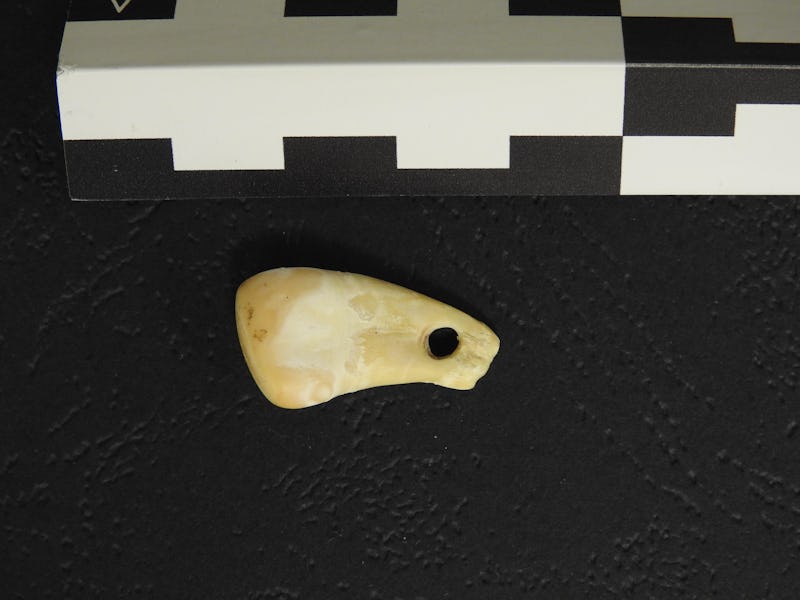20,000-Year-Old DNA Finally Revealed Who Wore This Ancient Elk Tooth Pendant
Found in Denisova Cave, this pendant carved from an elk tooth could mark the beginning of a new way to find ancient DNA.

For hundreds of thousands of years, a secluded cave in Siberia was a refuge for our ancient ancestors. Carved into the foothills of the Altai Mountains, Denisova Cave holds a treasure trove of tools and trinkets made by Neanderthals, Denisovans, and Homo sapiens.
But since the site was a crossroads for several species, it’s often unclear who made which artifacts. Individual identities are nearly impossible to trace back, thanks to the lack of formal burials and written records. But DNA can help piece together some personal details.
Recently, researchers were able to extract DNA from a 20,000-year-old bone pendant to determine the sex and genetic identity of an early human who once wore it. The team details a unique extraction method in the journal Nature that could help uncover the stories of more artifacts in the future while keeping them fully intact.
An artistic interpretation of the pendant at Denisova Cave.
Drawing out DNA
At sites like Denisova Cave, pieces of the past are tightly packed together in layers of sediment. Objects thousands of years apart can be buried in close proximity, making it difficult to distinguish which ancient humans were responsible for what objects.
Extracting DNA from sediment can offer clues, but it doesn’t tell the full story.
“When we started looking into sediments, we were kind of making a step forward to see which groups were present in those layers,” Elena Essel, a molecular biologist at the Max Planck Institute for Evolutionary Anthropology, tells Inverse. “But still … we did not have a direct way to say who made which artifact.”
Directly testing cultural objects for ancient DNA is an idea that’s been floating around for a while, Essel explains. However, standard DNA analysis is often a destructive process, requiring chemicals that can degrade materials. Researchers typically cut or shave off a sample of material for testing so as not to damage the entire object.
The entrance to Denisova Cave.
That’s led to efforts in recent years to find new methods of DNA extraction that don’t require irreparable harm to precious artifacts. In the new report, Essel’s team tested out a way to draw out DNA from objects made of bone by giving them several baths in a solution that’s gentle yet effective.
Wash on hot
Essel compares the process to a “washing machine” for ancient objects. After clearing away bits of sediment, a lab technician submerges each item in a sodium phosphate buffer with a bit of detergent. Then, the object is washed three times at increasingly higher temperatures to release bits of DNA.
First, the team wanted to see if the phosphate solution would alter the structure of animal bones. They were particularly interested in changes to the microscopic structures on the surface of the bones, which can be damaged by some chemicals.
“If you imagine the surface, it really looks like mountains and valleys,” Essel explains. After exposure to EDTA, a chemical agent commonly used for DNA extraction, “the mountains are basically gone. It's a very smooth, homogenous surface.”
But after the phosphate extraction, “you still see these mountains and valleys,” says Essel. “What you lose … is the sediment particles attached to the surface.”
The elk tooth pendant discovered in Denisova Cave.
Only trace amounts of animal DNA could be detected from the first set of animal bone samples, which were collected decades ago from Quinçay Cave in France. Contamination from the hands of archaeologists who dug the bones up made it tough to detect any ancient human DNA.
To get around the contamination problem, the researchers then tested the new method on freshly collected samples from Bacho Kiro Cave in Bulgaria and Denisova Cave that were excavated by archaeologists wearing gloves and face masks.
Fresh is best
Three bone pendants from Bacho Kiro and one from Denisova were put to the test. After going through the washing process, the new samples showed way lower levels of modern DNA contamination.
However, the Bacho Kiro pendants didn’t yield any ancient human DNA, which Essel says could be due to a combination of factors. It’s possible the pendants weren’t handled long enough by ancient humans or that DNA just didn’t preserve well under the conditions the object was buried in, for example.
The pendant was carved from an elk tooth.
But the Denisova pendant yielded the best results. Mitochondrial DNA was preserved over 20,000 years and indicated that the tooth used to make the pendant belonged to an elk. An analysis of DNA from the individual who wore or handled it indicated that they were a female Homo sapien.
The individual also bore genetic similarities to a group of Ancient North Eurasian individuals who were previously known to live farther east in Siberia.
Answering the big questions
So far, the Denisova pendant was the only sample to yield ancient human DNA with the new extraction method. Essel notes that the team would like to apply the method to a larger number of samples in order to test its efficacy.
However, new DNA extractions will likely be limited to freshly excavated samples since contamination is widespread in historical ones.
That’s a shame, Essel says, “because there are so many super exciting samples sitting in collections [and] we would love to learn about who made them [and] who used them.”
To avoid a repeat of the past, Essel stresses that simply wearing gloves and face masks can help limit contamination during excavation.
“It doesn't guarantee that your sample has ancient human DNA but increases the chances that if there is ancient human DNA that it's possible to detect it and start asking these extremely exciting questions [about the past],” she says.